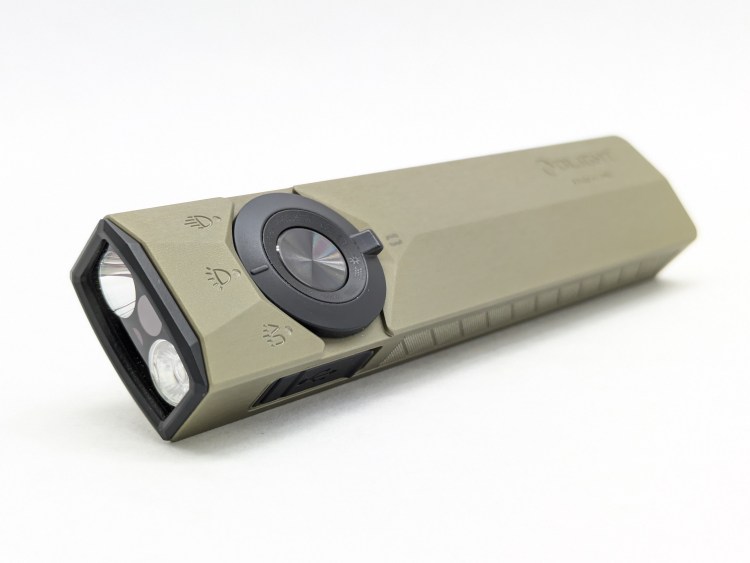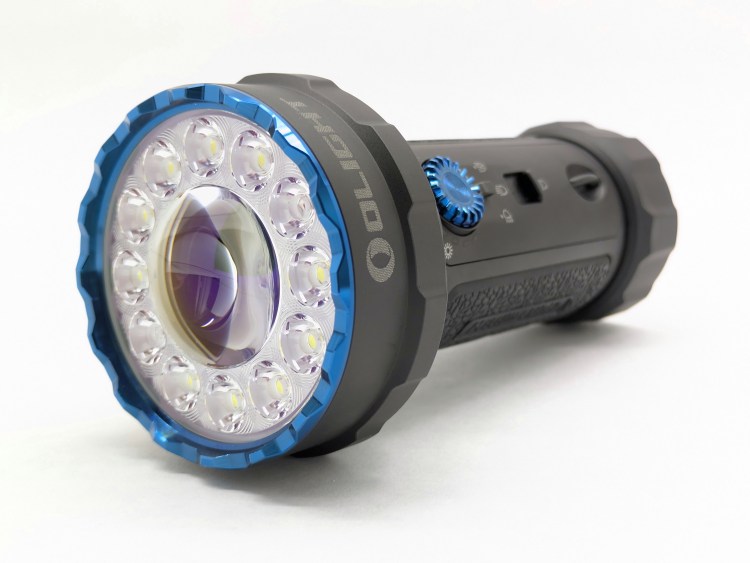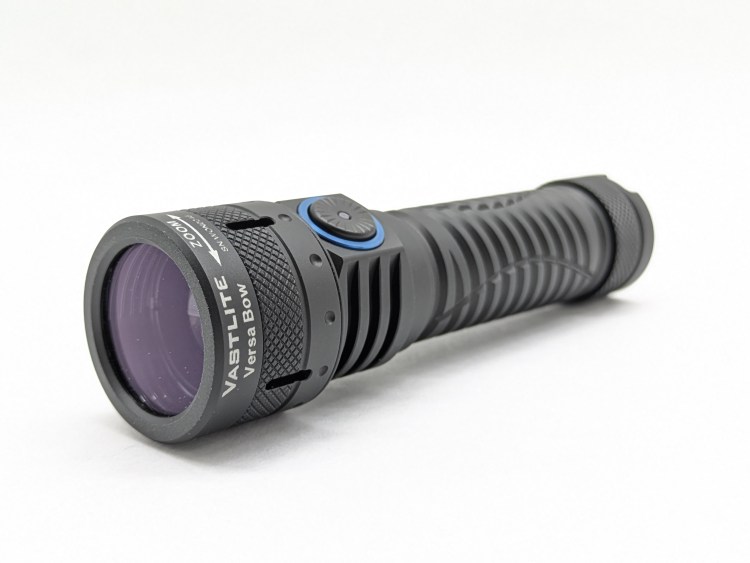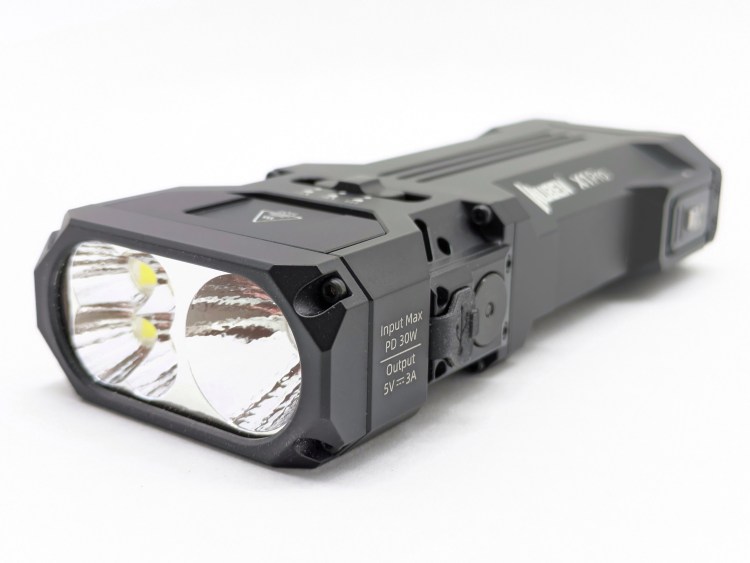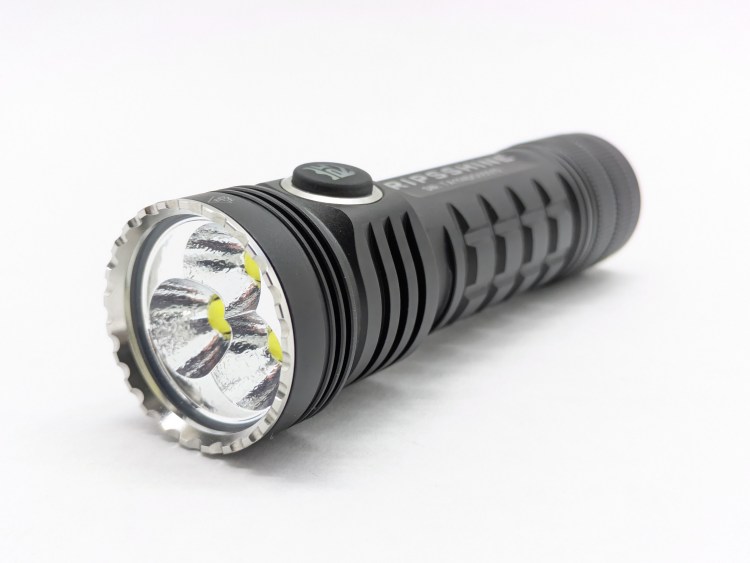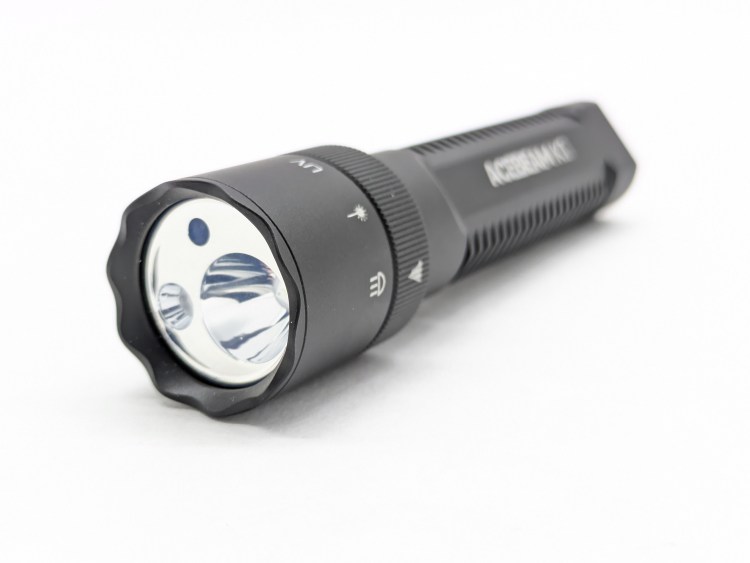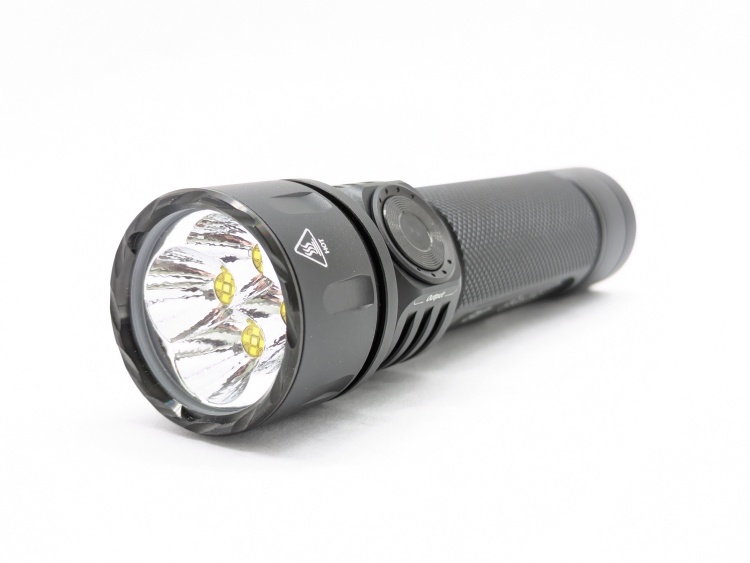Contents
- Pricing & Availability
- What comes in the box?
- Design & Construction
- Size & Measurements
- User Interface
- Emitter & Beam
- Mode Chart
- Runtime
- Driver & Regulation
- Switch
- Carry & Ergonomics
- Batteries & Charging
- Already Being Replaced?
- Competition
- Conclusion
Pricing & Availability
Acebeam sent me this light in exchange for an honest review. Here is the official product page where you can see current pricing.
What comes in the box?
The light comes in a satin retail box with printing all over and a window to show the light inside. There’s a vacuum formed plastic insert inside to hold the light in place and a smaller box that holds all the accessories. The box contains:
- The light itself
- Battery (inside the light)
- User manual & warranty card
- USB A-to-C charging cable
- Wrist lanyard
- Spare O-rings
Design & Construction
Terminator M2 looks cool. It reminds me of an IR laser/illuminator device for a rifle. They were clearly going for a modern tacti-cool look and it works. I know some people will dislike the laser etching all over the light, particularly the caution paragraph. Personally, I think it adds to the look.
Build quality is top-notch. All the machining and finishing are flawless. It feels solid and dense in the hand with no wobbles or rattles. Even the toggle switch feels super solid, and that’s difficult to achieve. One small gripe is that the o-ring in the tailcap likes to pop out when you are tightening the tailcap, so be careful when charging the battery. Fortunately, spares are included.
Size & Measurements
Acebeam L19 2.0 | Wuben X1 | Acebeam Terminator M2 | Skilhunt M300 | Olight Warrior X 4

| Measurement | Measured (mm) |
|---|---|
| Width | 49.0 |
| Thickness (not including clip, which adds 5.1mm) | 24.5 |
| Length | 97.2 |
| Switch Diameter | 13.7 |
| Switch Proudness | -0.5 |
| Lens Thickness | U/A |
| Lens Diameter | U/A |
| MCPCB Size | U/A |
| Driver Size | U/A |
| Included Battery Length | 70.0 |
Weight with included battery: 200g
User Interface
Acebeam did a great job with the UI. It’s largely the same standard UI that’s common on most lights with an E-switch, plus a toggle for flood/throw. That’s exactly what I like to see on multi-channel lights.
The actions are # of presses followed by a hold (H) or a release (C). So, “1C” is one click and release. “2H” is two clicks but you hold down the last one.
| State | Action | Result |
|---|---|---|
| Off | 1C | On (mode memory) |
| Off | 1H (short) | Moonlight (not memorized) |
| Off | 1H (long) | RGB (color cycle) |
| Off | 1H (long-er) | Lockout |
| Any | 2C | Turbo |
| Any | 3C | Turbo + Spotlight |
| On | 1C | Off |
| On | 1H | Cycle mode (low-med1-med2-high) |
| Moonlight | 1H | Low |
| RGB | 1H | Cycle mode (color cycle, red, green, blue, green beacon, red SOS) |
| Lockout | 1C | Battery indicator flashes red and green |
| Lockout | 1H | Unlock & activate Moonlight |
Spotlight UI: (Ostensibly) High only. If you triple-click, it will also turn on the flood LEDs. There’s also a possible bug where entering and exiting lockout mode in the spotlight channel will enter a lower mode.
What they got right:
- Channel switching is on a separate switch. That’s so much better than using yet another combination of clicks and holds on the main button.
- Clicking turns the light on/off and holding the button changes modes. That’s the way almost all e-switch flashlights should work. It’s intuitive and quick.
- Most of the common shortcuts work. Moonlight & Turbo both have shortcuts that work the same way as most other lights. They work very well and there’s no learning curve for these when switching lights. Strobe is a little different.
- Turbo & Moonlight are not memorized. Each has a dedicated shortcut, so you can access them quickly without overriding your memorized mode.
- 1H from Moonlight goes to Low. That means you can get to Low mode without having to go through brighter modes if you don’t have it memorized.
- It’s possible to activate flood & spot simultaneously via 3C. It’s good to be able to turn both channels on at the same time, but I wish the shortcut were 2H instead of 3C.
What they got wrong:
- There is one too many brightness levels. This is my personal preference, but I like my lights to have 5 levels so that each mode has a name (Moonlight, Low, Medium, High, and Turbo) and there’s a true medium mode that’s right in the middle. With 6 modes, there’s no middle mode and they had to add numbers to the mode names “Med1” and “Med2”.
- The Strobe shortcut is atypical. Normally, Strobe is activated by 3C. However, Acebeam decided to make 3C activate both channels at the same time, so they pushed the Strobe shortcut back to 4C. It would have been better for 2H to activate both channels at the same time, and then 3C could activate Strobe like it does on most lights.
Emitter & Beam


Terminator M2 has three different groups of LEDs. Flood, Spot, and RGB.
Flood: I chose the Nichia 519A 5000K 90CRI LEDs but they also offer “Cool White 6500K” LEDs if you want maximum brightness and efficiency. I’m delighted that these LEDs sit behind a Carclo 10507 triple optic because it works beautifully with 519As. That combo produces a wide, crisp, clean hotspot.
Spot: I’m not sure what LED Acebeam is using for the Spot channel. I asked, but they haven’t gotten back to me. It has a round die and I think it might be from Yinding, but I’m not certain. If you know, let me know in the comments! Instead of a reflector or plastic optic, it sits under an aspheric glass lens that projects the image of that circular die out of the light. If it were a traditional square LED, it would produce a square beam so I’m glad they chose a round die. It’s cool white and standard CRI, which I also think are smart choices for a spotlight.
RGB: There’s a single RGB LED centered under the optic. Some lights like Skilhunt MiX-7 have bright RGB LEDs with optics so they can be used for illumination. Others like Emisar/Noctigon models have numerous, dim, and diffused RGB LEDs that look cool and stay on even when the light is off so you can locate it in the dark. Terminator M2’s RGB LED doesn’t do either of those things so, to me, it’s just a gimmick. Thankfully, it doesn’t get in the way of white light operation.
Access: The bezels are almost flush with the body so there’s nothing to really grab onto and turn. They each have five divets inside where you could turn them with the right tool, but I don’t have such a tool so I didn’t try and remove them. Update: BLF user Pöbel made a 3D-printable bezel tool for the M1 and M2!


The Flood Beam is great. The hotspot is wide with a crisp edge. There’s soft spill that fades out the further away you get from the hotspot. The color of these Nichia 519As is lovely as well.
The Spot Beam is even more crisp than the flood. It’s a tight, flat circle with no meaningful spill. There are a few artifacts around it but you can’t see them unless you’re shining the light at a white wall. It’s got some yellow at the edge of the spot but that’s typical for an aspheric lens. It’s got a lot of throw for such a small lens too, much more than most carryable flood/throw combo lights.
In the beamshots below, the basketball goal to the right of the hotspot is 39M away and the power pole in the center is 185M away.









Mode Chart
Disclaimer: All of my measurements are taken at turn-on. Lumen measurements were taken on a Texas Ace 3.5″ Lumen Tube. A candela measurement was taken at 10 meters with an Opple Light Master III on the highest brightness, and other candela figures were calculated relative to that. CRI, CCT, & DUV data were taken for each mode from a few feet away at the center of the hotspot with the Opple Light Master and Waveform DUV Calculator. Runtime tests were performed with the Ceilingbounce app on my smartphone. All of these tests were performed with a fully charged included battery unless otherwise specified. I cannot measure moonlight directly, so moonlight readings are calculated based on the brightness relative to the next-lowest mode. None of this is professional equipment, so take all of these measurements with a grain of salt.

Above are the official specs, followed by my own measurements below.
| Level | Lumens | Candela | Throw (Meters) | CRI (Ra) | Color Temp. (K) | DUV (Tint) |
| Turbo | 2000 | 5400 | 147 | 97 | 4880 | -0.0016 |
| High | 730 | 1971 | 89 | 98 | 4810 | 0.0001 |
| Med 2 | 310 | 837 | 58 | 98 | 4730 | -0.0003 |
| Med 1 | 130 | 351 | 37 | 98 | 4650 | -0.0000 |
| Low | 28 | 76 | 17 | 98 | 4620 | -0.0006 |
| Moonlight | 0.4 | ~1 | ~2 | 98 | 4580 | -0.0010 |
| Spot | 750 | 77000 | 555 | 65 | 6180 | 0.0090 |
Mode Spacing / Ramp Speed: is good. There are no weirdly small or large jumps.
Runtime

Performance: Turbo and Spot last 2-3 minutes before large thermal stepdowns and that’s excellent. Sustained flood brightness is about 700 lumens and that’s about right for a light this size with high CRI LEDs. Sustained spot brightness is only about 300 lumens, but that’s still plenty to see far away with such a focused beam. Overall, performance is satisfactory.
Thermal regulation: Cooling the light with a desk fan in my “Turbo Cooled” test only extended the Turbo time by ~20% and did not have any other effects. If there is an active thermal regulation here, it sure doesn’t do much.
LVP (Low Voltage Protection): When the battery gets critically low, the light will step down to a low brightness level. Then eventually the light will shut completely off to protect the battery. The user manual says that happens at 2.7V. It’s possible to re-activate the light for a short time even after it’s shut itself off, so you’ll be able to find another battery in an emergency.
Driver & Regulation

Based on the light’s performance and Acebeam’s history, I believe this light has a Buck driver. Buck drivers typically provide good efficiency and regulation. I am not able to disassemble the light so I can’t get any more photos of the internals.

Regulation performance is decent. Turbo and Spot brightness drop a bit as the cell drains but they still provide respectable brightness. Other modes are unaffected until the battery is empty.
Note: All regulation measurements are taken at turn-on so they do not reflect any thermal or low voltage stepdowns that may occur. A value of 0 indicates low voltage shutoff immediately upon activation.
PWM: No PWM is visible to my eyes or camera, nor audible to my ears.
Parasitic Drain: 70 microamps. That should take ~5 years to drain the included battery.
Switch
Terminator M2 has two switches. There’s a main switch on the tail, and a channel switch on the side. They’re both good, but you can’t access both of them at the same time.

The Main Switch is a round, metal button on the tail. The switch action feels pretty good as it’s reasonably tactile and clicky. The switch itself is fine, but I don’t love the location. It’s just awkward to access it off-center on the tail. It would have been much better if it were located on the same side of the light as the channel switch, up toward the front where it says “ACEBEAM Terminator M2”.

The Channel Switch is excellent. I love when multi-channel lights like this have a separate, dedicated button for switching channels. This one is particularly excellent because it’s a sliding toggle switch with a fantastic action. It’s super clicky with a strong detent.
Carry & Ergonomics
Ergonomics: M2 isn’t the most ergonomic light. It’s comfortable enough to use once you fiddle with it for a bit and find a grip that works for you. I’ve found that a reverse grip in my left hand works well for accessing the main switch. Then I flip it around into a backwards forward grip to toggle the channel switch. It would be dramatically better if the main switch were on the face where it says “ACEBEAM Terminator M2” instead of on the tail.
Clip: This clip isn’t great, but it isn’t bad either. It screws on so it’s secure, but it leaves a large chunk of the light sticking out of my pocket. I prefer deep-carry clips that hold the light flush with the top of my pocket. This could be improved but it’s not a deal-breaker. Maybe someone will find a deep carry pocket knife clip that fits this screw pattern.

This light is wide in the pocket. It’s flat-ish so it doesn’t stick out much but it takes up a lot of space at the opening of my pocket. If your pockets have a relatively small opening it can be uncomfortable to reach past the light and get stuff at the bottom of your pocket.
Magnet: There is no magnet in the tailcap.
Batteries & Charging
Battery: M2 uses a single 18650 battery. A 3100mah protected button top USB-C rechargeable cell is included. I also tried an unprotected flat-top cell but it’s too short to work reliably. Even the slightest jostle would shut the light off.

Charging is facilitated by a USB-C port directly on the battery, so you have to remove it for charging. There’s no charging built into the light itself so you can’t use it while charging, but it should have better water/dust resistance since there’s no charging port. A short USB A-to-C cable is included.

Battery Indicator: There’s a battery indicator LED on one side of the light that will glow red or green to indicate battery status while the light is activated. Constant green means 20-100% charge. Constant red means 10-20% charge. Flashing red means 0-10% charge. Green meaning 20-100% is a very wide range, to the point that it’s not very useful to me. It’s better than no battery indicator, but I prefer indicators with more granular steps like 20-25% increments, especially if they use multiple LEDs instead of one with different colors.
Already Being Replaced?
Acebeam has a tweaked version of this light coming to the US around April called “M2-X”. The toggle switch has been replaced by channel-indicator LEDs and the battery indicator has been replaced by a channel-switcher button. Without knowing more about the potential UI differences, I can’t comment on whether M2 or M2-X is better. If you’re considering buying an M2, it may be worth waiting to see if M2-X is any good. For more info & photos, check out this Reddit post.
Competition
Here are some lights in the same class and how they compare.
- ~2x as expensive
- larger and no pocket clip
- larger 21700 battery size
- Focusable LEP instead of fixed focus LED for the spotlight
- Button instead of toggle switch for changing channel
- No RGB LEDs
- Both switches on the side of the light
Emisar/Noctigon Dual Channel: (various models can be spec’d with throw LEDs on one channel and floody LEDs on the other)
- less expensive
- feature-rich but complicated Anduril 2 UI
- only one switch
- magnetic tailcap (usually)
- more functional RGB secondary LEDs
- no integrated charging on pocketable models and they can’t fit USB batteries either
- no batteries included
This section is not comprehensive. If I didn’t include a particular light here, it doesn’t mean it’s bad or doesn’t deserve to be here. I simply cannot list every possible competitor.
Conclusion
My initial impression of this light wasn’t great because the awkward switch ergonomics surprised me. I really wish the main switch were on the same face as the toggle switch. After using it for a couple of days it really grew on me and I ended up carrying it much longer than most review lights. What struck me most about this review is how fun the light is. It’s fun to pull it out of my pocket, flip the toggle switch, and shoot a beam spotlight at things I need to see. For EDC utility, the high-CRI flood beam is so pleasant to use because of the neutral color temperature and tint. Even the gimmicky RGB LEDs are a fun party trick. It’s pricey, but I can’t think of any other flood/throw combo light that carries as comfortably, throws as far, or is as well made as Acebeam Terminator M2.
Thanks to Acebeam for sending me this light for review!
























